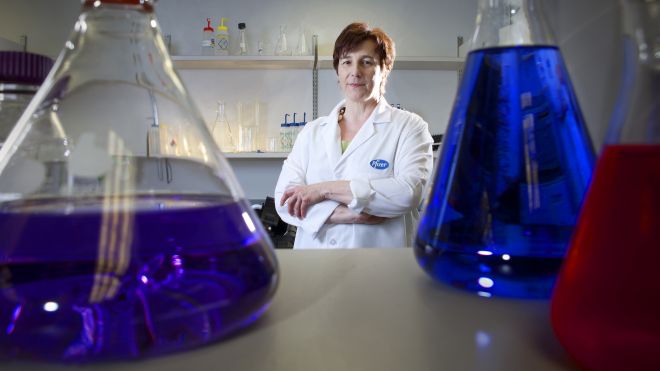
Kathrin Jansen is a microbiologist with at least two breakthrough vaccines to her name: she brought the cervical cancer vaccine Gardasil to market for Merck and helped develop the $4 billion a year pneumonia and meningitis vaccine Prevnar 13 for Pfizer. Jansen's next vaccine success could come by taming the superbug MRSA, a drug-resistant bacterium that she has seen ravage a healthy man up close and personally. Methicillin-resistant Staphylococcus aureus infects an estimated 53 million people globally and costs more than $20 billion a year to treat. In the United States alone, MRSA kills 20,000 Americans each year, exceeding annual deaths from AIDS. Jansen watched the infection unfold two years ago when visiting her stepfather, who was in the hospital for a hip replacement. The man in the bed next door died soon after MRSA attacked the vascular graft in his leg. “He went in healthy and died very quickly,” recalls Jansen, senior vice president of vaccine research and early development at Pfizer Inc, the world's largest drug maker. She says the experience steeled her resolve to develop an effective vaccine that could prevent such deaths. But Staphylococcus aureus has proven a tenacious adversary. In the past decade, vaccine candidates by Nabi Biopharmaceuticals and Merck & Co Inc failed in costly, late-stage clinical trials. Now, led by Jansen, Pfizer is taking a shot. Competitors, including vaccine giants GlaxoSmithKline, Novartis and Sanofi, are, too. And while the race could lead to a viable vaccine, potentially worth billions in sales, critics say companies may be risking costly failure with so much work on a bacterium that is still barely understood. 'Bag of trouble' Staph has been living in and on its human hosts for centuries. At any given time, 25 to 35 percent of individuals will test positive for staph, often with no symptoms. But the bacterium can cause a range of diseases from boils and impetigo to raging blood infections and deadly bacterial pneumonia. The discovery of penicillin in 1928 gave doctors a way to defeat staph infections, but overuse and misuse gave rise to drug-resistant staph. Methicillin was developed to overcome drug-resistance, but by the 1960s, staph evolved new defenses to overcome this more powerful version of penicillin. Thus began the decades-long battle against methicillin-resistant staph, now the most common cause of hospital-acquired infections that is increasingly spreading into army barracks, prisons and daycare centers. Dr. Bill Gruber, a Pfizer senior vice president who led clinical trials for Prevnar 13 and is running the company's Staph aureus trials, thinks of the bacterium as “a little bag of trouble.” “Basically, it has a number of different toxins and defenses to try to defeat you.” That may explain why vaccines from Nabi and Merck failed. Both tried to defeat this bug by attacking on just one front. The vaccine by Nabi, now Biota Pharmaceuticals, focused only on the sugar capsule the bacteria make to hide from the immune system, while Merck's focused on a single protein that helps staph gets its nutrition. Neither lived up to expectations. “We've learned that just focusing on one target of Staph aureus might not be sufficient,” said Dr. Buddy Creech, an infectious diseases expert at Vanderbilt University. It takes stamina Jansen has been working on a Staph aureus vaccine for the past decade, first at Merck, then at Wyeth, and now at Pfizer. The East German-born scientist - who fled to the West in 1960 and earned her PhD in biology at Philipps University in Marburg - says it takes stamina to develop a successful vaccine, a process that can take 15 years or more. With the cervical cancer vaccine Gardasil, which had 2012 sales of $1.6 billion, it took 14 years from lab bench to government approval. “That's actually a fast development program,” she said. With Staph aureus, it took eight years from the first experiments to human safety trials. Now, it could take another seven to 10 years to wind up clinical trials, putting the team about midway through the process. Pfizer's initial vaccine targeted three mechanisms key to staph's survival and ability to cause disease. Two of those focused on sugar capsules. The third attacks a mechanism called “clumping factor,” which allows bacteria to stick to proteins when they enter the body. But Jansen's team wanted one more point of attack. They added a fourth antigen, a protein that allows the bacterium to steal manganese - a key nutrient - from host cells. The result is a four-antigen vaccine that generates antibody responses at distinct points of the life cycle of the bug. The company is testing this in Phase 1/Phase 2 trials in healthy adults in the United States. If Pfizer gets the results they hope for, likely later this year, the company expects to meet with regulators to iron out a plan for larger trials involving thousands of individuals. Initially, the vaccine would be aimed at preventing infections in millions of people globally who need elective procedures such as a hip replacement. Ultimately, it could be used to protect people at risk in the broader community. Rival vaccines Pfizer is furthest along, but the large, untapped market, estimated to be worth $3 billion to $4 billion a year, has drawn interest from several companies. GlaxoSmithKline has been quiet about its approach. The drugmaker had been partnering with Nabi's failed StaphVax candidate, and in 2009 bought another Nabi candidate called PentaStaph for $46 million. Company researchers declined to discuss their program, but Glaxo spokeswoman Melinda Stubbee confirmed the company has a four-component vaccine in Phase 1 development. “We are still evaluating the data and haven't yet announced plans to present the data or to pursue further development,” she said. NovaDigm Therapeutics, a private company based in Grand Forks, North Dakota, is developing a single-antigen vaccine that targets both staph and yeast infections caused by the fungus Candida. Other rivals with early-stage programs include Novartis, which has a vaccine in Phase 1 trials, and Sanofi, which is partnering with privately held biotech Syntiron. Although academic researchers applaud these efforts, they say companies may be rushing into trials too soon, especially when so much is unknown about how staph interacts with people. “Our development of Staphylococcal vaccines has predated an adequate understanding of the human response to infection,” Creech said. For instance, it is still not clear whether a Staph aureus vaccine that protects against skin infections will also protect individuals from bloodstream infections. It may be that instead of preventing infection, some vaccines will merely blunt infection. Dr. Robert Daum, who leads the MRSA Research Center at the University of Chicago Medical Center, doubts any of the current candidates will make it into widespread use. “I am convinced we need a vaccine. I'm just not sure anyone knows how to make one yet.” Jansen, who knows Daum, said she understands his skepticism. “I'm a microbiologist. I know bacteria pretty well. They are very potent adversaries.” She says there's a reason the company was not the first out of the gate. “We wanted to make sure that we looked under all the rocks and found what we needed to find.” Tests in animals and people suggest the vaccine induces production of antibodies that defeat staph's defenses and kill the bacteria. “To our knowledge, we are the only ones who have demonstrated very, very robust killing responses.” That was enough for Jansen. “We essentially said, 'That's it. We put it together as best as we know how. Now is the time to test it.'”source : http://www.foxnews.com/health/2013/05/23/pfizer-takes-its-shot-at-vaccine-for-evasive-mrsa-superbug/






